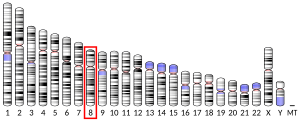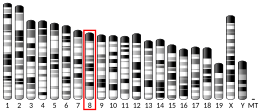MSR1
Macrophage scavenger receptor 1, also known as MSR1, is a protein which in humans is encoded by the MSR1 gene.[5][6] MSR1 has also been designated CD204 (cluster of differentiation 204).
Function
[edit]This gene encodes the class A macrophage scavenger receptors, which include three different types (1, 2, 3) generated by alternative splicing of this gene. These receptors or isoforms are trimeric integral membrane glycoproteins and have been implicated in many macrophage-associated physiological and pathological processes including atherosclerosis, Alzheimer's disease, and host defense. They were thought to be expressed macrophage-specific, but recently shown to be present on different dendritic cells classes, too.[7]
The isoforms type 1 and type 2 are functional receptors and are able to mediate the endocytosis of modified low density lipoproteins (LDLs). The isoform type 3 does not internalize modified LDL (acetyl-LDL) despite having the domain shown to mediate this function in the types 1 and 2 isoforms. It has an altered intracellular processing and is trapped within the endoplasmic reticulum, making it unable to perform endocytosis. The isoform type 3 can inhibit the function of isoforms type 1 and type 2 when co-expressed, indicating a dominant negative effect and suggesting a mechanism for regulation of scavenger receptor activity in macrophages.[5]
Biotechnology application
[edit]Macrophage scavenger receptor has been shown to mediate adhesion of macrophages and other cell lines to tissue culture plastic.[8]
Interactions
[edit]MSR1 has been shown to interact with HSPA1A.[9]
References
[edit]- ^ a b c GRCh38: Ensembl release 89: ENSG00000038945 – Ensembl, May 2017
- ^ a b c GRCm38: Ensembl release 89: ENSMUSG00000025044 – Ensembl, May 2017
- ^ "Human PubMed Reference:". National Center for Biotechnology Information, U.S. National Library of Medicine.
- ^ "Mouse PubMed Reference:". National Center for Biotechnology Information, U.S. National Library of Medicine.
- ^ a b "Entrez Gene: MSR1 macrophage scavenger receptor 1".
- ^ Matsumoto A, Naito M, Itakura H, Ikemoto S, Asaoka H, Hayakawa I, Kanamori H, Aburatani H, Takaku F, Suzuki H (December 1990). "Human macrophage scavenger receptors: primary structure, expression, and localization in atherosclerotic lesions". Proc. Natl. Acad. Sci. U.S.A. 87 (23): 9133–7. Bibcode:1990PNAS...87.9133M. doi:10.1073/pnas.87.23.9133. PMC 55118. PMID 2251254.
- ^ Herber DL, Cao W, Nefedova Y, Novitskiy SV, Nagaraj S, Tyurin VA, Corzo A, Cho HI, Celis E, Lennox B, Knight SC, Padhya T, McCaffrey TV, McCaffrey JC, Antonia S, Fishman M, Ferris RL, Kagan VE, Gabrilovich DI (August 2010). "Lipid accumulation and dendritic cell dysfunction in cancer". Nat. Med. 16 (8): 880–6. doi:10.1038/nm.2172. PMC 2917488. PMID 20622859.
- ^ Robbins AK, Horlick RA (August 1998). "Macrophage scavenger receptor confers an adherent phenotype to cells in culture". BioTechniques. 25 (2): 240–4. doi:10.2144/98252st04. PMID 9714883.
- ^ Nakamura, Toshinobu; Hinagata Jun-ichi; Tanaka Toshiki; Imanishi Takeshi; Wada Youichiro; Kodama Tatsuhiko; Doi Takefumi (Jan 2002). "HSP90, HSP70, and GAPDH directly interact with the cytoplasmic domain of macrophage scavenger receptors". Biochem. Biophys. Res. Commun. 290 (2). United States: 858–64. doi:10.1006/bbrc.2001.6271. ISSN 0006-291X. PMID 11785981.
Further reading
[edit]- Asaoka H, Matsumoto A, Itakura H, Kodama T (1993). "[Structural and function of the human macrophage scavenger receptor]". Nippon Rinsho. 51 (6): 1677–83. PMID 8391600.
- Naito M, Suzuki H, Mori T, et al. (1992). "Coexpression of type I and type II human macrophage scavenger receptors in macrophages of various organs and foam cells in atherosclerotic lesions". Am. J. Pathol. 141 (3): 591–9. PMC 1886699. PMID 1519666.
- Matsumoto A, Naito M, Itakura H, et al. (1991). "Human macrophage scavenger receptors: primary structure, expression, and localization in atherosclerotic lesions". Proc. Natl. Acad. Sci. U.S.A. 87 (23): 9133–7. Bibcode:1990PNAS...87.9133M. doi:10.1073/pnas.87.23.9133. PMC 55118. PMID 2251254.
- Emi M, Asaoka H, Matsumoto A, et al. (1993). "Structure, organization, and chromosomal mapping of the human macrophage scavenger receptor gene". J. Biol. Chem. 268 (3): 2120–5. doi:10.1016/S0021-9258(18)53970-3. PMID 8093617.
- Ashkenas J, Penman M, Vasile E, et al. (1993). "Structures and high and low affinity ligand binding properties of murine type I and type II macrophage scavenger receptors". J. Lipid Res. 34 (6): 983–1000. doi:10.1016/S0022-2275(20)39684-X. PMID 8394868.
- Resnick D, Chatterton JE, Schwartz K, et al. (1996). "Structures of class A macrophage scavenger receptors. Electron microscopic study of flexible, multidomain, fibrous proteins and determination of the disulfide bond pattern of the scavenger receptor cysteine-rich domain". J. Biol. Chem. 271 (43): 26924–30. doi:10.1074/jbc.271.43.26924. PMID 8900177.
- Hsu HY, Hajjar DP, Khan KM, Falcone DJ (1998). "Ligand binding to macrophage scavenger receptor-A induces urokinase-type plasminogen activator expression by a protein kinase-dependent signaling pathway". J. Biol. Chem. 273 (2): 1240–6. doi:10.1074/jbc.273.2.1240. PMID 9422792.
- Gough PJ, Greaves DR, Gordon S (1998). "A naturally occurring isoform of the human macrophage scavenger receptor (SR-A) gene generated by alternative splicing blocks modified LDL uptake". J. Lipid Res. 39 (3): 531–43. doi:10.1016/S0022-2275(20)33292-2. PMID 9548586.
- Teupser D, Thiery J, Seidel D (1999). "Alpha-tocopherol down-regulates scavenger receptor activity in macrophages". Atherosclerosis. 144 (1): 109–15. doi:10.1016/S0021-9150(99)00040-4. PMID 10381284.
- Nakamura T, Hinagata J, Tanaka T, et al. (2002). "HSP90, HSP70, and GAPDH directly interact with the cytoplasmic domain of macrophage scavenger receptors". Biochem. Biophys. Res. Commun. 290 (2): 858–64. doi:10.1006/bbrc.2001.6271. PMID 11785981.
- Tomokiyo R, Jinnouchi K, Honda M, et al. (2002). "Production, characterization, and interspecies reactivities of monoclonal antibodies against human class A macrophage scavenger receptors". Atherosclerosis. 161 (1): 123–32. doi:10.1016/S0021-9150(01)00624-4. PMID 11882324.
- Xu J, Zheng SL, Komiya A, et al. (2002). "Germline mutations and sequence variants of the macrophage scavenger receptor 1 gene are associated with prostate cancer risk". Nat. Genet. 32 (2): 321–5. doi:10.1038/ng994. PMID 12244320. S2CID 13499753.
- Xu J, Zheng SL, Komiya A, et al. (2003). "Common sequence variants of the macrophage scavenger receptor 1 gene are associated with prostate cancer risk". Am. J. Hum. Genet. 72 (1): 208–12. doi:10.1086/345802. PMC 378627. PMID 12471593.
- Strausberg RL, Feingold EA, Grouse LH, et al. (2003). "Generation and initial analysis of more than 15,000 full-length human and mouse cDNA sequences". Proc. Natl. Acad. Sci. U.S.A. 99 (26): 16899–903. Bibcode:2002PNAS...9916899M. doi:10.1073/pnas.242603899. PMC 139241. PMID 12477932.
- Kosswig N, Rice S, Daugherty A, Post SR (2003). "Class A scavenger receptor-mediated adhesion and internalization require distinct cytoplasmic domains". J. Biol. Chem. 278 (36): 34219–25. doi:10.1074/jbc.M303465200. PMID 12819208.
- Miller DC, Zheng SL, Dunn RL, et al. (2003). "Germ-line mutations of the macrophage scavenger receptor 1 gene: association with prostate cancer risk in African-American men". Cancer Res. 63 (13): 3486–9. PMID 12839931.
- Wang L, McDonnell SK, Cunningham JM, et al. (2003). "No association of germline alteration of MSR1 with prostate cancer risk". Nat. Genet. 35 (2): 128–9. doi:10.1038/ng1239. PMID 12958598. S2CID 30170866.
- Nupponen NN, Wallén MJ, Ponciano D, et al. (2004). "Mutational analysis of susceptibility genes RNASEL/HPC1, ELAC2/HPC2, and MSR1 in sporadic prostate cancer". Genes Chromosomes Cancer. 39 (2): 119–25. doi:10.1002/gcc.10308. PMID 14695991. S2CID 19353783.
- Hillman RT, Green RE, Brenner SE (2005). "An unappreciated role for RNA surveillance". Genome Biol. 5 (2): R8. doi:10.1186/gb-2004-5-2-r8. PMC 395752. PMID 14759258.
This article incorporates text from the United States National Library of Medicine, which is in the public domain.






